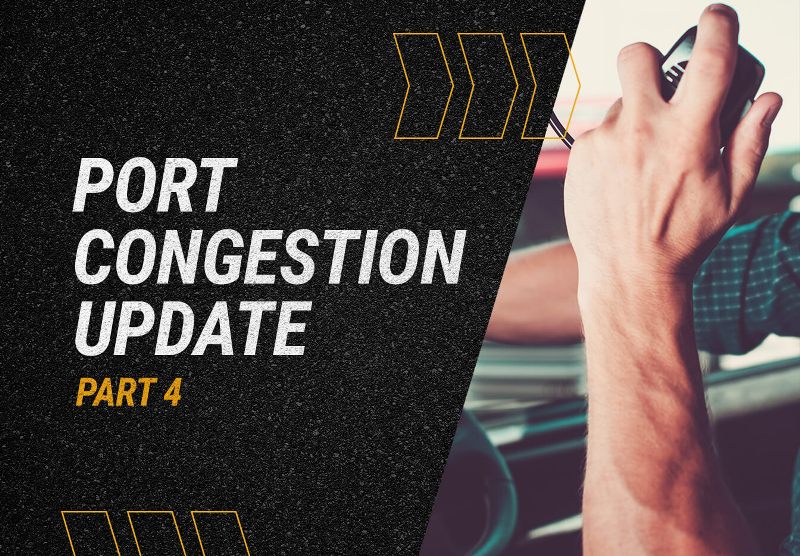
In our ongoing blog series, we have examined some of the major factors causing the recent coastal port congestion. Today, we continue looking at the ripple effects — notably, the crucial role truck drivers play in our supply chain and the contributing factors resulting in the current truck driver shortage.
Even as technological advancements continue to shape and shift the supply chain, truck drivers will remain vital to the transport of our goods. More than 70% of all freight moved across the United States requires handling by a driver. The 3.5 million drivers in this country collectively cover more than 430 billion miles every year. In addition to their physical ability and stamina, their knowledge of the road — managing traffic and navigating closures — is vital. Drivers are present in nearly every step in the supply chain, from delivering raw goods to manufacturing to finished products to our doorsteps. Without them, the world we are accustomed to living grinds to a halt.
With the alarming trend of a shortage of truck drivers that has only continued to escalate since the start of the pandemic, we feel the impact it’s having on all of us — empty store shelves, higher prices, and long wait times for durable goods just to name a few. We explore four primary reasons that are contributing to the truck driver shortage and ways to attract and retain drivers during this time.
Navigating Uncertainty
While every industry connected to the supply chain is experiencing disruption, a shortfall of truck drivers is among the most urgent. Driver shortages, which have been a reality before COVID-19 disruptions, have only intensified in recent months, due, in part, to ever-increasing consumer demand.
Four of the most pressing factors impacting and exacerbating driver shortages are:
- Loss of Labor Force Due to the Pandemic
When COVID-19 closures and restrictions crashed down upon the economy as a whole, some industries were impacted more than others. Trucking was undoubtedly one of them. At first, closures and delays meant fewer hours and more restrictions, leading many drivers to seek early retirement or a career shift. At the same time, many training facilities for new drivers were shuttered. The industry has not rebounded these fundamental losses.
- Training and Mandates
Unlike other jobs where new workers can be thrust into a position with little-to-no training, drivers require many hours of professional training and licensing. When you add the reality of ever-changing regulations — such as new hours of service (HOS) and Electronic Logging Devices (ELD) mandates — it’s no wonder seasoned drivers unwilling to adjust to the new rules are leaving the field in higher numbers than in previous generations. - An Aging Workforce
Speaking of which, the current average truck driver age is 55 years old. While this means there is a lot of experience out on the road, it also means many are facing retirement, considering early retirement, or pondering alternative careers as the industry changes. - Excessive Stress
During the pandemic, life on the road became increasingly riddled with challenges, including closed rest stops, limited dining options, and increased safety requirements. Even when restrictions were relaxed, the stress of continuing uncertainty and long hours has pushed drivers to limits they might have, in another time, pushed through. Instead, drivers are taking more time off or have decided to transition to another career that provides a better work/life balance.
So, What Can Be Done to Attract and Retain Drivers?
Fixing a broken supply chain and replenishing a dwindling workforce will not happen quickly. But there is hope that meaningful change can occur over time, even in small doses. While the trucking industry looks at ways to cast a wider net to attract young adults and millennials, there are some ways to retain drivers and gain traction in this challenging time.
- Recognize and Reward – While pay hikes are needed to remain competitive, it’s not necessarily all about wages. Simply being recognized and appreciated can make a difference in someone’s attitude. Earning a reputation for treating drivers with respect can improve your overall relationships (and inch out the competition for good workers).
- Enhance Efficiency – Working smarter instead of harder is a good strategy for any business. In logistics, however, measurable improvements can turn mere minutes into major profits. While some more experienced drivers can resist ever-changing technology, companies that utilize tools that support drivers while providing real-time visibility to customers will remain ahead.
- Leverage a Network – Keeping track of availability at any given time can be quite a challenge. Consider leveraging an existing network that can easily connect prospective brokers with qualified drivers. This can strengthen provider and partner relationships as well as shorten the time spent seeking jobs and workers.
In this time of increased anxiety and decreased certainty, reaching out to find a reliable partner you trust can make all the difference. EASE has a track record of delivering proven results — especially in times of crisis — and can offer end-to-end managed logistics services with unparalleled customer service. Our extensive, strategic network of highly vetted transportation and logistics partners means we’re equipped with the proper solution for every supply chain need.
Keep tuning in as we continue to explore the very latest developments on coastal port congestion. In the next blog update, we’ll focus on growing consumer demand coupled with the supply chain crunch that will cause holiday shopping snags. Read part 5. In the meantime, catch up on the series by reading part 1, part 2 and part 3 to learn more.
Contact us today for innovative solutions to your transportation needs.


